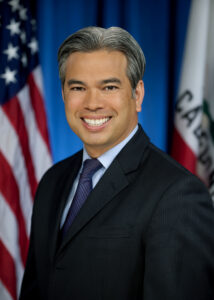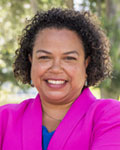
By Antonio Ray Harvey, California Black Media
California Attorney General (AG) Rob Bonta is urging Californians to take advantage of recent changes to the Public Service Loan Forgiveness (PSLF) and Temporary Expanded Public Service Loan Forgiveness (TEPSLF) programs.

Bonta’s announcement coincides with a CNBC survey that reports 31% of Black women are disproportionately impacted by student debt. Also, four years after graduation, 48% of Black students owe an average of 12.5% more than they borrowed, according to the Educational Data Initiative (EDI).
Assemblymember Mia Bonta (D-Alameda), a member of the California Legislative Black Caucus (CLBC) shared her own struggles with paying back student debt she owed.
“I graduated with over $150,000 in student debt. I was in my 20s then,” she said. “I didn’t make my final payment until almost 20 years later, just in time to send my oldest daughter to college.”

According to Bonta, a Black woman owes 112% of the loan amount she takes out 12 years after starting college. For a Latina, 12 years after starting college, she will owe 86% of that loan.
“Black and Latino students, coming from low-income communities take on a disproportionately amount of school debt,” Bonta said. “I witness this every single day.”
The PSLF and TEPSLF programs are entirely different from President Joe Biden’s plan for targeted student debt cancellation to borrowers with loans held by the Department of Education. Qualifying borrowers must have “annual income of under $125,000 (for individuals) or under $250,000 (for married couples or heads of households). Borrowers who qualify can have up to $10,000 worth of eligible debt canceled. If the borrower received a Pell Grant, the borrower could have up to a total of $20,000 of debt canceled.
Biden also extended the pause on student loan repayment, interest, and collections through December 31, 2022.
Last year, the U.S. Department of Education (ED) launched a limited-time PSLF Waiver opportunity that runs through Oct. 31. It allows eligible borrowers to receive credit for past student loan payments that would otherwise not qualify under the PSLF program.
ED improved the PSLF program in response to a lawsuit and years-long advocacy by a number of state attorneys general and others urging ED to fix the broken program.
Following resolution of the lawsuit, AG Bonta has continued to advocate for changes to the PSLF program. The California Department of Justice (DOJ) is taking part in the California Student Loan Debt Challenge to raise
awareness about the PSLF program to help DOJ employees’ access loan forgiveness.
“On behalf of the more than 5,000 public servants at the California Department of Justice, I’m proud to take the California Student Debt Challenge,” AG Bonta said. “Our public servants work day-in and day-out on behalf of the people of California as our nurses, teachers, first responders, state workers, and more. I urge you to take advantage of the new PSLF Limited Waiver Opportunity before the Oct.31 deadline.”
California ranks No. 13 among states on student loan debt with borrowers owing an average of $37,084. California’s student loan debt adds up to $141.8 billion, the largest amount of any state.
According to EDI, student loan debt statistics show tremendous disparities among racial and ethnic groups.
African American college graduates owe an average of $25,000 more debt than White graduates. Four years after graduation, 48% of Black students owe an average of 12.5% more than they borrowed.
Black student borrowers are the most likely to struggle financially due to student loan debt, with 29% making monthly payments of $350 or more. About 3% of California borrowers owe more than $200,000 and nearly 10% of the state’s population have student loan debt.
The moratorium on federal student loan payments expires on Aug. 31. A total of 43 million Americans owe student loan debt — worth $1.6 trillion, federal data shows.
“Thankfully now, there are federal and state programs that can play a critical role in reducing or eliminating student debt altogether,” Mia Bonta said. “Now we have this last opportunity to spread awareness about these programs. Beyond that, we have to simplify the application process and create a better coordinated, outreach program between institutions of higher learning, the government, and the private sector.”
Under the limited PSLF waiver rules, any past periods of repayment count as a qualifying payment, regardless of loan type, repayment plan, or whether or not the borrower made a payment, or if the payment was made in full or on time.
Each borrower needs to work for a qualifying employer, private or non-profit. The Temporary change applies to borrowers with Direct Loans, those who have already consolidated into the Direct Loan Program, and those who consolidate into the Direct Loan Program by Oct. 31, 2022.
There are two requirements in order to receive additional qualifying payments:
Full-time employment – Borrowers must have worked full-time for a qualifying employer during the prior periods of repayment. They receive credit only for periods of repayment after Oct. 1, 2007, which is when the PSLF program began.
Loan consolidation – Borrowers with Federal Family Education Loan (FFEL) Program loans, Federal Perkins Loans, or other types of federal student loans that are not Direct Loans must consolidate those loans into the Direct Loan program by Oct. 31, 2022.
If the borrower had Direct Loans and had PSLF employment certified, ED will award additional payments without further action. If necessary, Federal Student Aid may contact the borrower to certify additional months of employment.
An employer needs to be a governmental organization, a 501(c)(3) organization, or a not-for-profit organization that provides a designated public service in order to qualify for PSLF under normal rules and the Limited PSLF Waiver.
“My team has advocated for years for the Department of Education to fix this broken program, and with the recent changes under the Biden Administration, Californians are finally beginning to receive relief,” AG Bonta stated.
Get more information on the loan forgiveness program.


